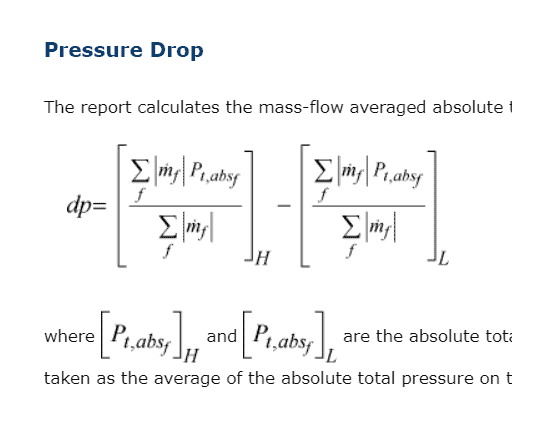Download the simulation file which correspond to the example in this blog post:
[wpdm_package id=’7761′]
In Simcenter STAR-CCM+ there is a pre-defined report named Pressure drop report. In the picture below you can see how this report is set up, using one high pressure boundary (inlet in this case) and one low pressure boundary (outlet in this case). If you want to evaluate pressure drop you can use this report, or create your own Expression report by subtracting the low pressure from the high (absolute total) pressure (but then, don’t forget taking the hydrostatic pressure loss into account).
Since it can be difficult to know exactly which pressures to use, we will in this week’s blog post take a closer look at field functions for pressure. We will look at how the field functions are defined, and the reports connected to pressure drop. There will also be a discussion regarding Reference density, because it is an important parameter in both the pressure drop report and in many different types of simulations.

Definition of different pressures
In the pre-defined pressure drop report we evaluate the mass-flow averaged absolute total pressure. Mass-flow averaged means that you are multiplying the pressure at each face with the mass-flow flowing through the face, and then divide the sum of pressures with the total mass flow. This results in a pressure value reported where you have more mass-flow being weighted heavier in the averaging.

The absolute total pressure is defined by the absolute pressure plus a term which is possible to simplify if incompressible fluids are used. If you are using ideal gas this term depends on the variables ratio of specific heat and Mach number, but if you assume the fluid to be incompressible you use the dynamic pressure (meaning density times velocity squared divided by two).

Absolute pressure is defined as in the picture below.

Note that the reference pressure defined in Continua -> Physics 1 (default name) -> Reference values should be set to a value around which your simulation operates so that you don’t have to work with pressures that are too far from the reference value. If you define the reference value far from the pressures that you operate within you can end up with a rounding error which may affect your solution.
The first terms in the absolute pressure refers to the calculated pressure plus the reference pressure set in the reference values (1atm = 101325Pa as default). The last term is the hydrostatic pressure, which uses the gravitational constant and also measures the deviation from the reference altitude at the location where the report is evaluated. The report also uses the reference density, meaning that the value will directly impact your results extracted from the report.

Since the reference density is important to set correctly, a discussion section regarding this variable follows below.
Reference density
The reference density is not only used in pressure reports including hydrostatic pressure, but also the buoyancy term in multiphase simulations. Therefore, in simulations including multiphase flow and compressible fluids it can be more complicated to choose a value for the reference density than in simulations with single phase flow and incompressible fluid. In incompressible single phase simulations you should use the fluid density as reference density, since calculated density that differs from the reference density will introduce numerical errors which can result in instability of the solution. For multiphase flow, where you have several fluids, there are three options on which value to use for the reference density:
- Fluid with lowest density
- Set reference density to zero
- Fluid with highest density
In these simulations it is common to have one phase with much higher density than the other, resulting in inevitable rounding errors for one phase. Still, there are no clear guidelines on how to set the reference density for these simulations, but it is most common to use the fluid with the lowest density.
Most guidelines describe how to use the low–density fluid as reference density, but there are also guidelines for using the value zero as reference density. One thing that we at Volupe have seen though, is that in simulations with low velocities and high hydrostatic pressures you can benefit from using the high–density fluid as reference density to minimize the numerical errors. So, if you obtain unphysical behavior in your simulation one solution could be to change the reference density.
Pressure drop reports
In the downloadable file at the top of this page you find a simulation file where pressure drop is calculated using different definitions. Please download the file and investigate the set up if you are interested in details of the reports.
The first report in the simulation is the pre-defined pressure drop report, which is the recommended to use. Here you take all terms related to pressure into account, even the hydrostatic pressure. After the pre-defined pressure drop report there are three different manual pressure drop reports defined; by first reporting the inlet pressure, then the outlet pressure and then subtracting the outlet from the inlet pressure via an expression report. The absolute total pressure report gives the same result as the pre-defined pressure drop report (it uses the mass flow averaged values, which is the case for all reports discussed in this blog post, and it also includes the hydrostatic pressure). For the absolute pressure reports (named as number 2) the definition is not including the dynamic pressure, therefore this report gives a lower pressure drop value than the other reports discussed so far. There is also a pressure drop report for the total pressure included in the simulation (named as number 3), since this is a report that is often used for reporting the pressure drop. The total pressure is the calculated pressure (static pressure) plus the dynamic pressure. Since the hydrostatic pressure is not included the results will be very different from the pre-defined pressure drop report – which is something that we thought was worth highlighting by creating this blog post (in the downloadable file the geometry is very high to give a significant hydro static pressure term, for demonstrating the importance of the term). The hydrostatic term is the only thing that will differ between the inlet and outlet since all the reference pressures etc will exist on both the inlet and outlet.
See picture below for the reports discussed in this section (print screen from the downloadable file), where you also find a report for density to use as reference density.

We at Volupe hope that this blog post has been interesting for you, and that you now have better knowledge regarding how the pressure you evaluate is defined when you are reporting results in your simulation.
Author

Christoffer Johansson, M.Sc.
support@volupe.com
+46764479945




